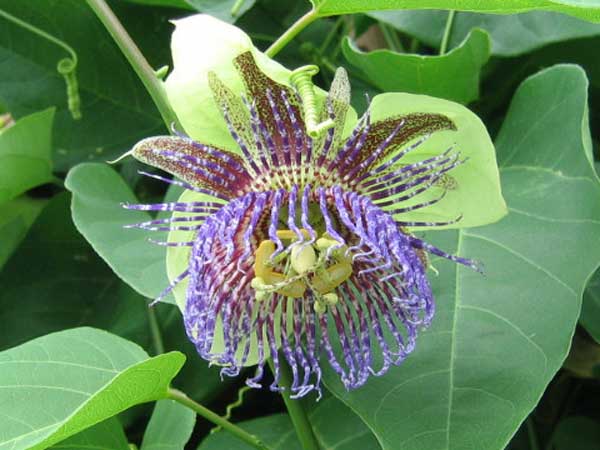
Passiflora maliformis (*)
Classification System: APG IV
Superregnum: Eukaryota
Regnum: Plantae
Cladus: Angiosperms
Cladus: Eudicots
Cladus: Core eudicots
Cladus: Rosids
Cladus: Eurosids I
Ordo: Malpighiales
Familia: Passifloraceae
Genus: Passiflora
Subgenus: P. subg. Passiflora
Supersectio: P. supersect. Laurifolia
Series: P. ser. Tiliifoliae
Species: Passiflora maliformis
Name
Passiflora maliformis L., 1753.
Synonyms
Passiflora caudata A.H. Gentry, Phytologia vol. 47, 2, 103. 1980.
Passiflora laurifolia Guill., Mem. Mus. Hist. Nat. n.s. Bot. vol. 8, 148. 1859., nom. illeg. non L. (1753)
Passiflora maliformis var. pubescens Planch. & Linden ex Triana & Planch., Ann. Sci. Nat. Bot., sér. 5 17: 149. 1873.
Passiflora ornata Kunth , Nov. Gen. Sp. vol. 2, 129. 1817.
References
Linnaeus, C. 1753. Species Plantarum 2: 956.
Tropicos.org 2009. Passiflora maliformis. Missouri Botanical Garden. Published on the internet. Accessed: 17 Feb 2009.
Passiflora maliformis, the sweet calabash, conch apple, wild purple passionfruit, or sweet cup, is a smallish (5cm) passionfruit with purple, yellow or green skin and a greyed-yellow to orange pulp that is aromatically-scented and -flavoured. It is a fast-growing vine, growing best in somewhat cooler-than-tropical climates. The rind is particularly hard and tougher than most passionfruits. It is usually eaten fresh or used to flavour drinks. It is a native to the Caribbean, Central America and Northern South America.[1]
Description
[icon]
This section needs expansion. You can help by adding to it. (September 2019)
P. maliformis flowers
Passiflora maliformis is a fast-growing evergreen shrub or vine. The slender, woody stems can reach lengths of 3–10 metres and are equipped with tendrils by means of which the plant climbs other plants or structures for support. The green or orange-green fruit is up to 4cm in diameter. The skin of this fruit can be hard so a hammer is sometimes needed to open it for consumption.[2]
Cultivation
It is usually grown from seeds but may also be propagated by stem-cuttings and layering.[3] Grafting onto other Passiflora rootstock can improve hardiness.[4] Passiflora maliformis grows in the warm, wet tropics the plants require a temperature no lower than around 16°c when they are flowering in order to ensure fruit set. Passiflora species tend to flower and fruit more freely when grown in soils of only moderate fertility. Seedlings can commence fruiting when only 1 - 2 years old. Plants in this genus are notably resistant to honey fungus.[5]
Nutrition
Passiflora maliformis arils contain 85.44% water, 7.17% net carbohydrates, 3.63% fibre, 2.2% protein, and 0.45% fat (see table). A 100-gram amount provides 42 kilocalories and is an excellent source of magnesium and phosphorus as well as a significant source of other minerals (see table). The fruit also contains various organic acids and phenolic compounds which are responsible for the aroma and flavour.[6] It is commonly eaten raw or made into a drink, it is said to have a flavor similar to grape.
References
"Sweet Calabash - Passiflora maliformis". Trade Winds Fruit. 2013. Retrieved 2019-09-17.
"Sweet Calabash - Passiflora maliformis - Seeds". www.tradewindsfruit.com. Retrieved 2019-10-09.
Ken Fern (2019-06-13). "Tropical Plants Database". tropical.theferns.info. Retrieved 2019-09-17.
"Passiflora Maliformis (Sweet Calabash) Seeds". Hierbas del Perú. Retrieved 2019-09-17.
"Passiflora maliformis - Useful Tropical Plants". tropical.theferns.info. Retrieved 2019-10-09.
Ramaiya, S.D.; Bujang, J.B.; Zakaria, M.H.; Saupi, N. (2018-12-01). "Nutritional, mineral and organic acid composition of passion fruit (Passiflora species)" (PDF). Food Research. 3 (3): 231–240. doi:10.26656/fr.2017.3(3).233. Retrieved 2019-09-17.
Retrieved from "http://en.wikipedia.org/"
All text is available under the terms of the GNU Free Documentation License

